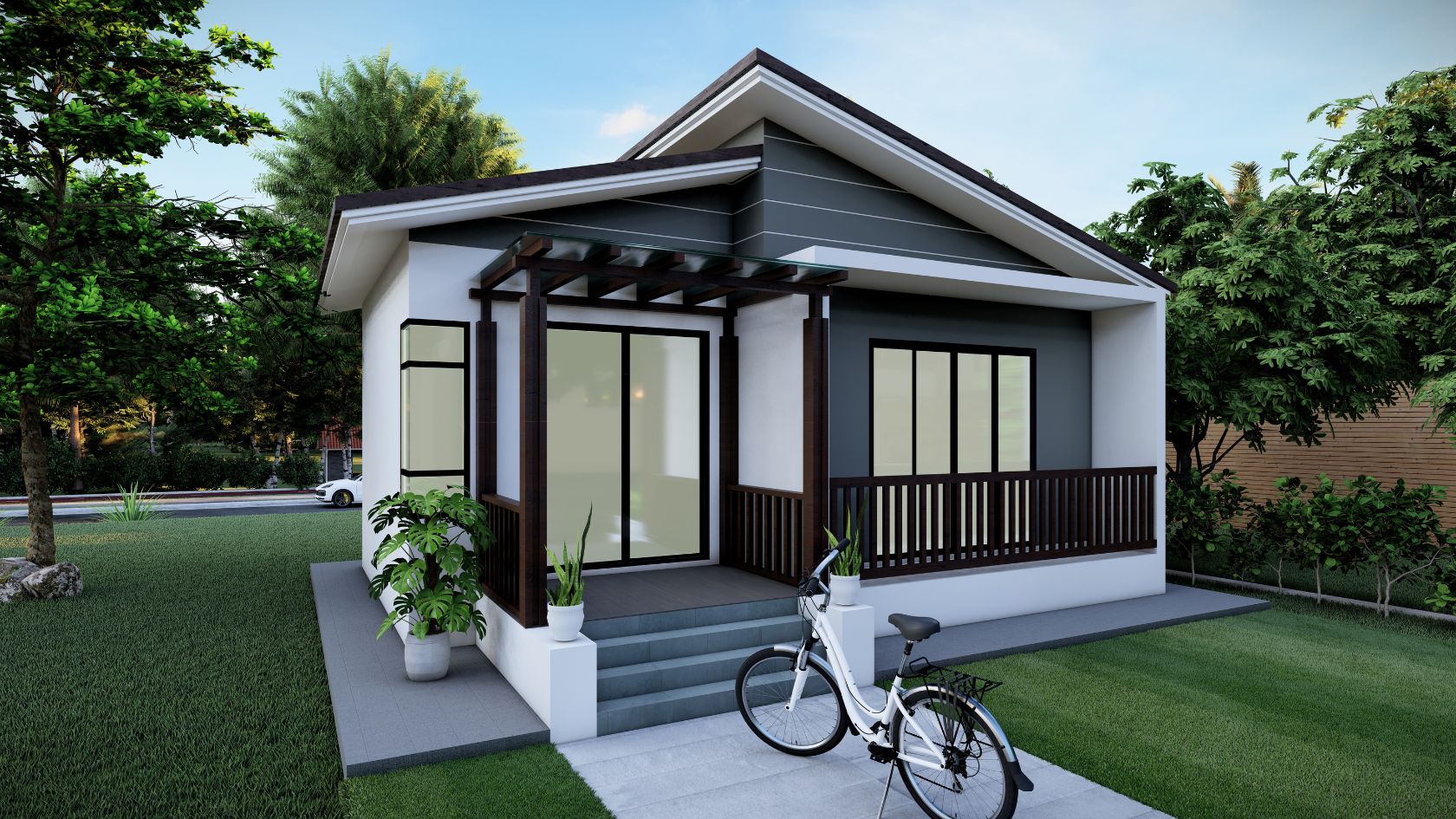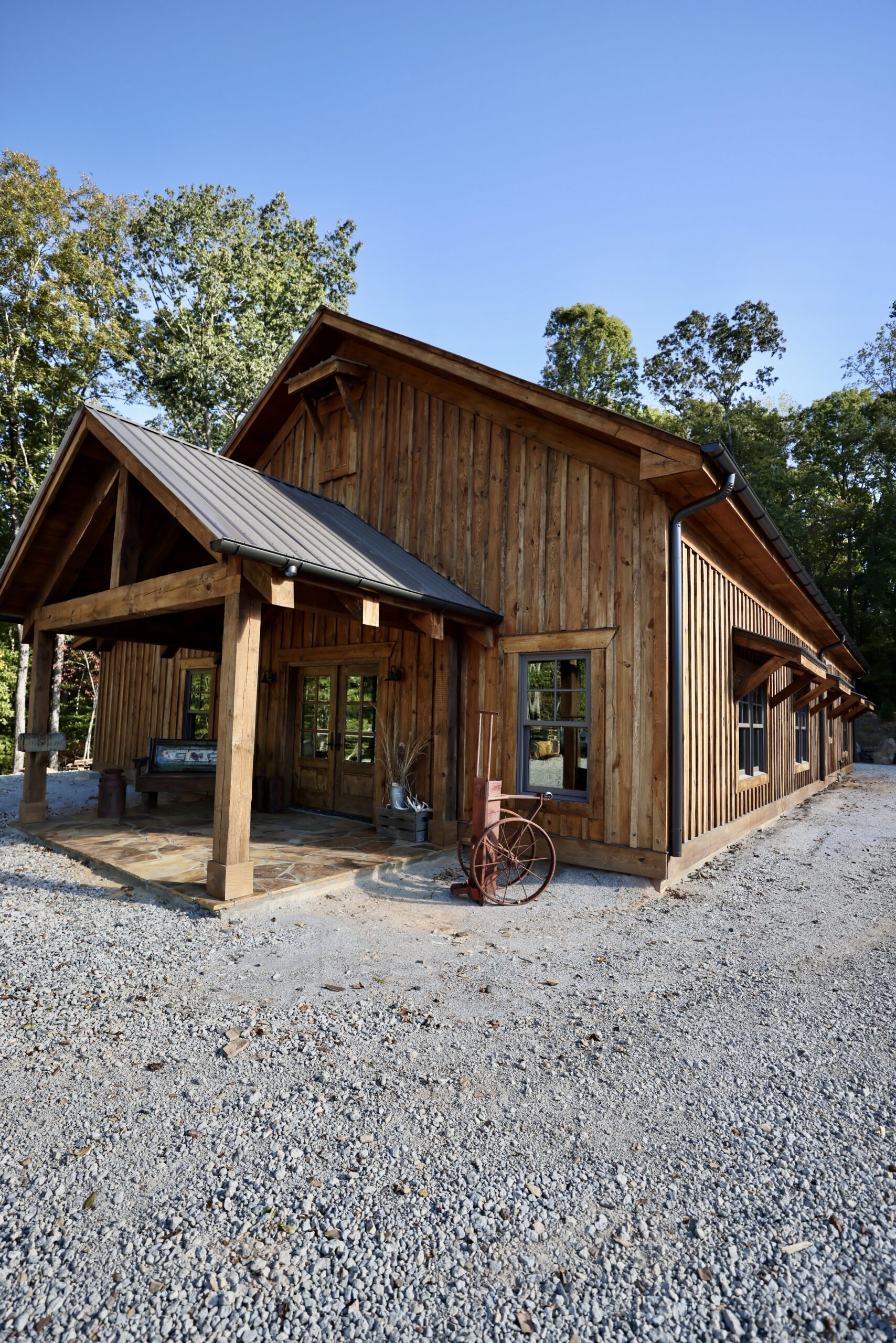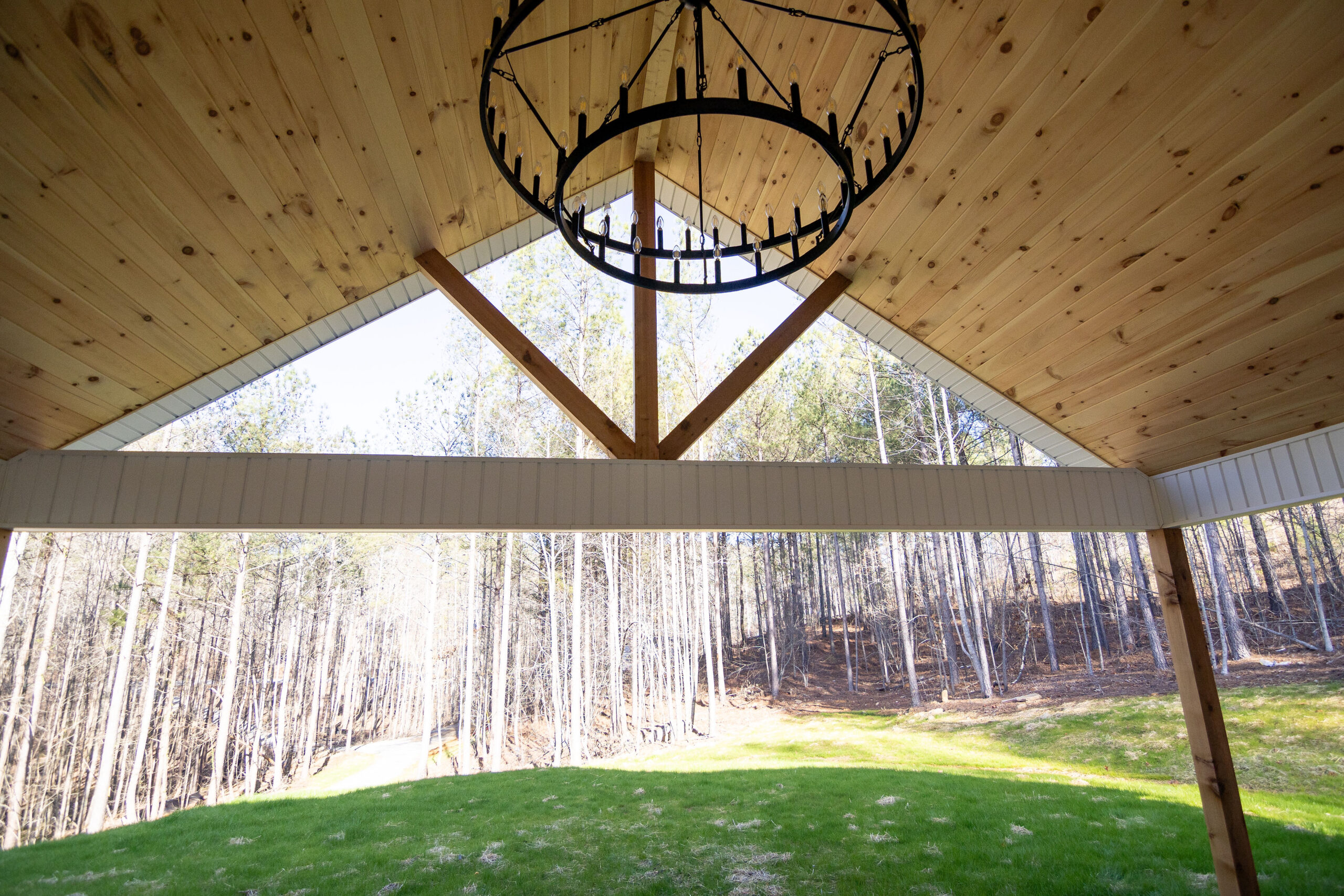
Building a small custom home in North Georgia offers a unique opportunity to live efficiently while embracing the region’s beautiful landscapes. Whether you’re aiming for a cozy cabin in the Blue Ridge Mountains, a lakeside retreat on Lake Lanier, or a charming residence in a quaint North Georgia town, maximizing space is key to creating a home that feels open, functional, and comfortable.
Living in a smaller space doesn’t mean you have to sacrifice style or comfort. With the right design choices, you can create a home that feels spacious and well-organized while blending seamlessly with North Georgia’s scenic surroundings. Let’s dive into the top space-saving tips to help you get the most out of your small custom home.
1. Open Floor Plans for Maximum Flexibility
Want Your Small Home to Feel Larger?
One of the most effective ways to make a small home feel larger is to opt for an open floor plan. This design strategy eliminates walls and partitions that can make a space feel boxed in, creating a more open and airy atmosphere. Combining your living, dining, and kitchen areas into one continuous space helps to maximize both functionality and the flow of natural light throughout the home.
Why Open Floor Plans Work in Small Homes:
- Maximizes natural light: Without walls blocking the flow of sunlight, your home will feel brighter and more expansive. Open layouts help the natural light from your windows reach every corner of the home.
- Encourages multifunctional spaces: An open floor plan allows for more flexibility. Your living room can double as an office, and your kitchen island can serve as a dining table or workspace.
- Easier for entertaining: Even in a small home, having an open space makes it easier to host guests without feeling cramped or cluttered.
How to Design a Smart Open Floor Plan:
- Use furniture to define areas: Even in an open layout, you can still create defined zones using furniture. For example, a sofa can serve as a divider between the living room and the dining area.
- Keep traffic flow in mind: Make sure the open space has a clear path for foot traffic, and avoid placing furniture in high-traffic areas.
- Consistent flooring: Using the same flooring throughout your open floor plan helps create visual continuity, making the space feel larger.
2. Multi-Functional Furniture: Less Is More
Need One Piece of Furniture to Do More?
When you’re working with limited square footage, it’s crucial to select multi-functional furniture that serves more than one purpose. The best pieces are not only practical but also stylish, helping to maintain the aesthetic appeal of your small custom home.
Examples of Multi-Functional Furniture:
- Storage beds: A bed with built-in drawers or compartments underneath can eliminate the need for a bulky dresser, freeing up valuable floor space in the bedroom. This is especially useful in tight spaces where every inch counts.
- Murphy beds: A Murphy bed (also known as a wall bed) is perfect for small homes because it can fold up into the wall during the day, instantly transforming your bedroom into a home office or living space.
- Expandable dining tables: A small dining table that can expand when you have guests over is perfect for saving space without sacrificing the ability to entertain.
- Sofa beds: A sofa bed can function as seating during the day and transform into a guest bed at night, giving you flexibility without the need for a dedicated guest room.
Why Multi-Functional Furniture Is Essential for Small Homes:
- Saves space: Furniture that serves more than one purpose reduces clutter and frees up space for other activities.
- Increases functionality: A single piece of furniture can fulfill multiple roles, making it easier to maintain a clean, organized, and efficient home.
- Stylish options: Modern multi-functional furniture comes in a variety of styles, so you don’t have to compromise on aesthetics to save space.
3. Vertical Storage Solutions: Look Up
Running Out of Floor Space? Use the Walls!
If you’re low on floor space, it’s time to start thinking vertically. Vertical storage solutions are perfect for small homes because they make use of underutilized wall space, keeping your floors clear and free of clutter. This approach is especially useful in kitchens, bathrooms, bedrooms, and entryways.
Ideas for Vertical Storage:
- Tall bookshelves and cabinets: Install bookshelves or cabinets that reach all the way to the ceiling. This provides ample storage without taking up much floor space. In the kitchen, consider tall pantry cabinets or shelving for cookware and pantry items.
- Wall-mounted shelves: Shelving units mounted high on the wall are ideal for storing items you don’t need to access every day. In living rooms or bedrooms, they can hold books, decor, or storage baskets.
- Pegboards and hooks: In the kitchen, a pegboard or series of wall hooks can hold pots, pans, utensils, and other tools, freeing up cabinet space. In the bathroom, hooks and shelving can hold towels, toiletries, and other essentials.
- Over-the-door organizers: Take advantage of the back of doors by hanging over-the-door organizers for shoes, bags, cleaning supplies, or pantry items. These are great for keeping small, easily lost items organized and within reach.
Benefits of Vertical Storage:
- Maximizes space: Vertical storage solutions take advantage of wall space, freeing up valuable floor space.
- Reduces clutter: By using the walls for storage, you keep countertops, tables, and floors free of clutter, making the home feel more open.
- Customizable: Shelving units, hooks, and organizers can be easily customized to fit your space and storage needs.
4. Built-In Storage and Furniture: Custom Solutions
Want a Custom Look Without Losing Space?
One of the major advantages of building a custom home is the ability to design built-in storage and furniture that fits perfectly into the available space. Built-in storage is one of the best ways to maximize the functionality of small homes without sacrificing style.
Built-In Ideas for Small Custom Homes:
- Built-in benches with storage: Add a built-in bench along one wall in the dining area, complete with storage underneath for extra linens, dishes, or seasonal items.
- Window seats: A window seat can double as a cozy reading nook and hidden storage space for books, blankets, or children’s toys.
- Under-stair storage: Use the space under the stairs for built-in drawers, shelving, or even a small desk area. This turns what would otherwise be dead space into something functional.
- Built-in closets and wardrobes: Customize your closets with built-in shelving, drawers, and hanging racks that make the most of the vertical space. This is especially important in small bedrooms where freestanding wardrobes might be too bulky.
Advantages of Built-In Storage:
- Seamless design: Built-ins blend with the architecture of your home, providing a clean, cohesive look.
- Maximizes awkward spaces: Built-ins are perfect for making use of odd corners, nooks, or alcoves that would otherwise go unused.
- Increases storage capacity: Built-ins often provide more storage than freestanding furniture, helping to keep the home organized and clutter-free.
5. Use Pocket and Sliding Doors: Save Space on Entryways
Need to Save Room Without Losing Functionality?
Traditional doors that swing open can take up valuable floor space in small homes, especially in narrow hallways, bathrooms, or closets. Pocket doors and sliding doors offer an elegant solution by disappearing into the wall or sliding along a track, allowing you to make the most of your limited space.
Why Pocket and Sliding Doors Are Ideal for Small Homes:
- Space-saving: Unlike traditional doors that require clearance to swing open, pocket and sliding doors don’t take up any floor space. This frees up room for furniture, storage, or easier movement in tight spaces.
- Aesthetic appeal: Sliding barn doors, for example, add a rustic or contemporary touch to your home’s design while remaining practical.
- Better flow: Pocket and sliding doors allow for better flow between rooms, making your home feel more open and connected.
Best Places for Pocket and Sliding Doors:
- Bathrooms: Installing a pocket door for the bathroom can free up valuable space for a larger vanity or storage.
- Closets: Sliding doors on closets eliminate the need for swing space, allowing for better use of the room.
- Room dividers: Sliding doors or partitions can be used to divide open spaces into different zones without closing them off completely.
6. Create Zones in Open Spaces: Functionality Meets Flow
How Do You Make a Small Space Feel More Functional?
In a smaller home, it’s essential to create zones for different activities, even within an open floor plan. Defining areas for living, dining, working, and sleeping makes the space feel more organized and purposeful. Using furniture, rugs, and lighting to create these zones helps to divide the space without building walls or creating a cluttered feel.
Tips for Creating Zones:
- Area rugs: Use area rugs to define different zones, such as a living area, dining space, or home office. Rugs help visually break up a space and make it easier to designate areas for specific activities.
- Room dividers: Consider using folding screens, bookcases, or curtains to create separation between different areas of an open space. For example, a bookshelf can serve as a divider between a living room and a home office without closing off the space entirely.
- Lighting: Use different types of lighting to highlight different zones. For example, pendant lights over the dining area, floor lamps by the reading nook, and task lighting for the home office can help define each zone.
- Furniture placement: Arrange your furniture to create natural boundaries between zones. For instance, you can use a sofa to separate the living room from the kitchen or a desk to define the home office.
Benefits of Creating Zones in Small Homes:
- Increases functionality: Zoning helps make each area of your home more functional, even within a single room. You can create designated spaces for work, relaxation, dining, and sleeping.
- Maintains an open feel: Zoning allows you to create structure within an open floor plan without building walls, preserving the flow and spaciousness of the home.
- Customizable: Zones can be easily reconfigured as your needs change, making this approach flexible and adaptable to your lifestyle.
7. Lofted Spaces for Sleeping or Storage: Go Vertical
Want to Use Every Inch of Your Home?
Lofted spaces can be a brilliant way to add extra storage or sleeping areas without taking up valuable floor space. Lofted beds or storage lofts take advantage of vertical height, making the space below available for other uses, like a home office, seating area, or play space.
How to Use Lofted Spaces:
- Lofted beds: A lofted bed can free up the floor space underneath for a desk, dresser, or lounge area. This is particularly useful in kids’ rooms or guest rooms.
- Storage lofts: High ceilings? Use the vertical space for a storage loft, where you can stow away items you don’t need to access every day, like seasonal clothes, camping gear, or extra linens.
- Mezzanine levels: In homes with extra-high ceilings, consider adding a small mezzanine level for additional living space, like a cozy reading nook or sleeping area.
Why Lofted Spaces Work:
- Maximizes vertical space: Lofting your bed or creating a storage loft allows you to make use of the height of your home without crowding the floor.
- Ideal for high ceilings: If your custom home has high ceilings, lofted spaces are an efficient way to make the most of the vertical space.
- Great for kids’ rooms: Loft beds are a hit with kids, and the space underneath can be used as a play area or study space.
8. Mirrors to Create the Illusion of Space: Reflect More Light
Want Your Small Home to Feel Bigger?
Mirrors are a classic design trick that can make small spaces feel larger by reflecting light and creating the illusion of depth. By strategically placing mirrors throughout your home, you can enhance the natural light, make rooms feel more open, and add a touch of elegance.
How to Use Mirrors to Make Your Space Feel Bigger:
- Large wall mirrors: A large mirror on one wall can reflect light from windows or lamps, making the room feel brighter and more open.
- Mirrored furniture: Incorporating mirrored furniture, like a coffee table or console, can create the illusion of more space by reflecting light and other objects in the room.
- Mirrored backsplashes: In kitchens or bathrooms, a mirrored backsplash can reflect light and give the illusion of more space in small rooms.
Benefits of Using Mirrors:
- Enhances natural light: Mirrors help bounce natural light around the room, making it feel brighter and more spacious.
- Creates depth: By reflecting the room, mirrors can create the illusion of depth, making a small room appear larger than it actually is.
- Adds elegance: A well-placed mirror adds a touch of elegance to any room, serving as both a functional and decorative element.
9. Optimize Kitchen and Bathroom Layouts: Function Over Form
Want a Functional Kitchen and Bathroom Without Wasting Space?
In a small custom home, the kitchen and bathroom are often the most challenging spaces to design efficiently. These rooms require plenty of storage and functionality, but space is often at a premium. A well-thought-out layout, combined with space-saving features, can make these areas highly efficient and practical.
Space-Saving Kitchen Ideas:
- Pull-out pantry shelves: Maximize cabinet space by installing pull-out shelves or drawers, making it easier to access items stored in the back.
- Compact appliances: Opt for compact, energy-efficient appliances designed for small spaces, such as narrow dishwashers, under-counter refrigerators, or combination washer-dryers.
- Hanging storage: Use hooks or wall-mounted racks to hang pots, pans, and utensils, freeing up cabinet and counter space.
Space-Saving Bathroom Ideas:
- Wall-mounted sinks and toilets: These fixtures take up less floor space and make the bathroom feel more open.
- Shower niches: Built-in niches in the shower are perfect for storing toiletries, eliminating the need for bulky shelves or shower caddies.
- Over-the-toilet storage: Utilize the space above the toilet with cabinets or open shelves to store towels, toiletries, and other essentials.
Why Layout Matters in Small Kitchens and Bathrooms:
- Maximizes efficiency: A well-planned layout ensures that every inch of space is functional and serves a purpose.
- Reduces clutter: Smart storage solutions, like pull-out shelves or over-the-door organizers, keep countertops clear and eliminate clutter.
- Enhances usability: A good layout makes it easier to move around and use the space effectively, even in tight quarters.
10. Light Colors and Simple Design: Brighten the Space
Want to Make a Small Space Feel Open and Airy?
Light colors and simple design choices can make a small home feel larger and more welcoming. When designing your small custom home, stick to light, neutral colors for the walls and furniture, and avoid busy patterns or overly ornate designs that can make the space feel cluttered.
Why Light Colors Work in Small Homes:
- Reflects light: Light colors reflect both natural and artificial light, making rooms feel brighter and more open. This is especially important in small spaces where natural light might be limited.
- Creates a calming atmosphere: Neutral and simple design choices create a calming, cohesive look, preventing small spaces from feeling chaotic or overwhelming.
- Provides a blank canvas: Light-colored walls and furniture create a neutral backdrop, allowing you to add pops of color through accessories, art, and decor without overwhelming the space.
How to Incorporate Simple Design:
- Minimalist decor: Keep the decor minimal and clutter-free. Choose a few statement pieces rather than overloading the space with decorative items.
- Streamlined furniture: Opt for furniture with clean lines and simple designs that don’t overpower the room. Avoid bulky or overly ornate pieces that can make the space feel cramped.
- Neutral color palette: Stick to soft, neutral tones like whites, beiges, grays, and pastels, which will make your space feel more expansive.
Conclusion: Making the Most of a Small Custom Home in North Georgia
Building a small custom home in North Georgia offers a unique opportunity to create a cozy, efficient, and stylish space that fits your lifestyle. With careful planning and the right design choices—like multi-functional furniture, vertical storage, open floor plans, and smart color schemes—you can make the most of every square foot in your home.
Whether you’re building a lakeside cabin, a mountain retreat, or a compact family home, these space-saving tips will help you create a functional, beautiful, and comfortable living environment that doesn’t feel cramped. It’s all about making smart use of the space you have while maintaining the charm and comfort of North Georgia living.
Looking to start building your small custom home? Lanier Home Builders specializes in creating homes that make the most of every square foot, offering expert design solutions for homes of all sizes. Ready to turn your vision into reality?
FAQs
How can I make a small custom home feel bigger?
Use an open floor plan, light colors, mirrors, and vertical storage solutions to create the illusion of space in a small custom home. Additionally, built-in furniture and multi-functional pieces help maximize usable space without cluttering the home.
What type of furniture is best for small homes?
Multi-functional furniture is key for small homes. Opt for pieces like storage beds, Murphy beds, and expandable dining tables that can serve multiple purposes, saving space and increasing functionality.
Is it possible to have an open floor plan in a small custom home?
Yes, an open floor plan is ideal for small homes because it eliminates unnecessary walls and barriers, making the space feel larger. Use furniture placement and area rugs to define different zones within the open space without closing it off.
How do I create storage in a small custom home?
Utilize vertical storage solutions like tall bookshelves, wall-mounted shelves, and over-the-door organizers. Built-in storage, such as under-stair cabinets or window seat storage, can also help maximize space without taking up additional floor area.
What are some ways to maximize natural light in a small home?
To maximize natural light in a small home, use open floor plans, large windows, light-colored walls, and strategically placed mirrors to reflect light. Opt for lightweight window treatments that allow light to flow into the space.
0

























Recent Comments